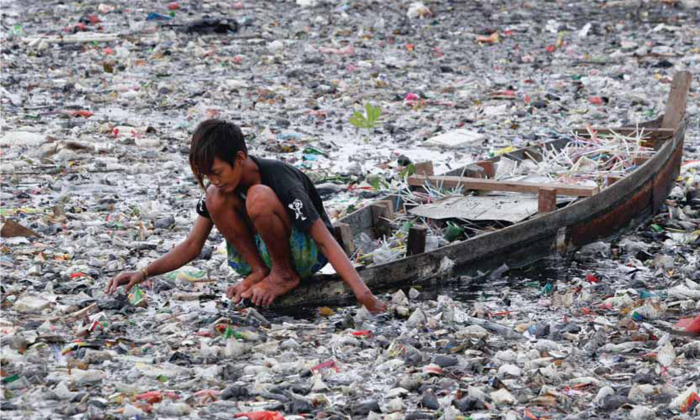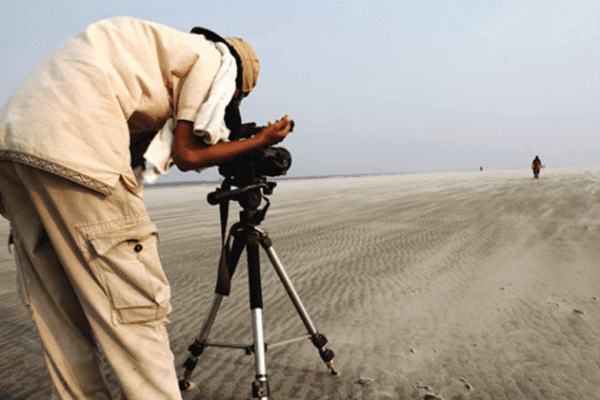Soon after Muni ki Reti at Rishikesh, the river disappears into the holy domesticity of the holy city. Up until this point, the water still shines, shimmering as it moves into the rocks, crosses its own hidden and fierce currents, and heals your skin and soul and eyes with its infinite restlessness and gurgling music. With the blues of its rippling kisses caressing your body, you don’t want to really die. Do you want to die, the river will ask you. Not yet. Not yet, you might say. Yes, as Kurosawa said in that epic film, of dying and living and refusing to die: ‘Madadayo’. Literally, Not Yet. Not Yet.
“The river has been murdered at this spot as a public spectacle, and the trickle which flows now to become the holy river at Haridwar, is an artificial construct, damned, chained into cemented canals, thrust into the self righteous arms of the Brahminism of divinity.”
But the great river has long died. Even the VHP saints who claim that the Bhagirathi/Ganga should flow ‘aviral’, without man-made obstacles, know perfectly well that the river has been killed at Tehri, even as thousands of acres of fertile land, habitat, memories and folk narratives have been submerged under the damned water, turned into a gigantic artificial reservoir where the Bhilangana and the Bhagirathi are mixed, as if by a big dam concrete monster mixer. Here, the spontaneous, pure as purity, gurgling, restless, more beautiful than all mountain rivers, the inheritor and carrier of a million primordial tales and magical myths, as an unruly primitive female, outside caste, clan, home, family or domesticity, arriving from the galaxy and the blue muddy glacier at Gaumukh, the unshackled lover, beloved, adulterous partner of an equally unruly, mad and tribal Shiva, not a goddess yet, but the beginning of shristi, has finally been stopped.
It has been tamed, tunnelled, traumatised, humiliated, chained, degraded, turned into a water storage tank, as if its waters have been choked in an empty plastic bottle, by yet another grotesque temple of modernity, to feed water and electricity into the insatiable and greedy stomach of the bloated, impersonal, ungrateful capital of modern India. The river has been murdered at this spot as a public spectacle, and the trickle which flows now to become the holy river at Haridwar, is an artificial construct, damned, chained into cemented canals, thrust into the self righteous arms of the Brahminism of divinity.
First, they killed the river at Tehri. After that, the river has been killed in the holy city of Haridwar, where the last rites of the dead will lead straight to salvation, along with assorted utensils full of ghee, miscellaneous food and puja objects, flowers and polythene, amidst the chanting of the Vedas which no one understands, surely, not even the priests and pandas. They quickly killed it by branding it as a goddess, trapped into the temples of holiness, domesticated by the daily rituals of Brahmanical Hinduism. She is no more that unruly primordial majestic young rebel without a family inheritance or caste hierarchy. She is no more that river.
While the damned and ‘canalled’ river, trapped on two sides by concrete, without its natural shores or originality, is worshipped at Haridwar, the original unchained river, in this same holy city, is left to die its infinite daily death, its unmapped, empty shores dried up like an epic tragedy in its absence of flow or current, soulless, waterless, meaningless, full of piss, shit, effluents, garbage, polythene, sewage, and, of course, remains of dead bodies. Har ki Pauri becomes the sacred space of this divine epicentre, but this too is an artificial construct, Hinduism’s manufactured consent, a theory trapped in its own intellectual and physical dishonesty.
By the time the river reaches Varanasi’s exquisite ghats, its filthy waters can make your skin glow with multiple rashes, the perversity in its flow perhaps more demonic and deadly than radioactive substances, its toxicity many million times more than the original zero level tolerance. Indeed, this toxic truth not only penetrates the soul of our myths and divinities, or the quest for nirvana, it also penetrates the ground water, the earth’s inner intestines, becomes the life giving substances which nourish nature, food cycles, animals and fish, plants, trees, fertile lands, vegetables. Check the cancer content of this poisoned netherworld, the paataal of this sacred river, and you will perhaps rediscover why so many women with no ‘fashionable life-style addictions of modernity’ are dying and dead of cancer in the rural Gangetic plains. So what do you do when the original life giving river, the docunarrative of survival, civilisation’s infinite testimony, becomes a cancer, worshipped with eyes closed?
On the day before Holi, Hindu women were pouring so much ghee and milk on the cowdung structure of Holika, that it flowed like ancient rhymes of this emaciated country, flush with rivers of ghee and milk. People walked barefoot in this slimy singular quagmire, in pristine synthesis with cow piss, cow shit, sewage, open naalas, puja samagri, dirty water, holy water, spit, human piss, discarded flowers, paper cups, plastic bottles, their feet and soul blessed with the filth in the backdrop of eternal incense. There are pimps all over, ready to become mediators if you want to feed the poor. The poor are waiting for the pimps, like models for a painter. There are pandas with a one way ticket to the moon (surely, not like the mafiosi at Puri).
You can’t walk one step without being stopped by hordes of beggars, their pleas pathetic, seeking you to return a divine favour for one good act a day leading to those steps to heaven. Even the beggars seem tired of this one-act play turning into a daily octopus like epic, relentless, endless, eternal. And yet, they will never rest. Every man is a potential victim of poverty’s curse. Those who have, those who don’t.
Across the bridge at Har ki Pauri, you sit on the dirty stairs of the ghat, trying to escape the holiness of it all. You lift your eyes. A fat woman with a tray full of ‘divine substances’ is gazing at you with abject benevolence. You can tell her, “No, I want to die.” But she insists. She will put a holy teeka on your forehead. And of course, you must pay for it. You have to live to pay for it. You can’t die. Not yet. Not yet.
You escape this last outpost of salvation towards the highway. Next to the ghat is a long playing record of Munni Badnaam Hui. One step forward, there is a green expanse. You breathe; you look for fresh air. Instead, you inhale a slow storm of human shit and piss. With sadhus walking barefoot through this perverse meadow of hope. And dark, emaciated, homeless children playing, like children. Protected by the gods and goddesses of this holy city.
Related














